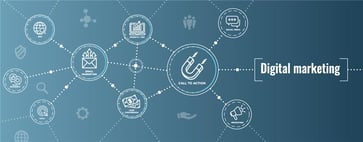 Some time ago I posted about eCommerce for distributors, and how it's the #1 way to grow your business. Whether or not you're ready to commit to a digital retailing strategy (it IS a big step), I encourage you to take a serious look at adopting digital marketing.
Some time ago I posted about eCommerce for distributors, and how it's the #1 way to grow your business. Whether or not you're ready to commit to a digital retailing strategy (it IS a big step), I encourage you to take a serious look at adopting digital marketing.
Why go digital?
To be blunt, if you're not marketing your business online, then you're not in the game. After all, when was the last time YOU used the yellow pages?
Online is the first place your potential customers go when they're looking for the products and services you offer and they need. If you're not marketing online, no one will find you.
Introducing Inbound
The big idea driving the move to digital marketing is "Inbound Marketing." Instead of high-volume, low-return cold-calling, you're letting your online content—highly targeted, and promoted via social media and email—do that work for you. As a result, you and your sales team can focus on closing deals faster with qualified prospects, nurturing relationships with existing customers, and moving on to the next deal faster.
Digital marketing starts with your brand.
Not to be confused (as it often is) with your logo, your brand is the distillation of your answers to these three core questions:
- Who are we?
- What do we do?
- For whom do we do it?
Throughout all your communications and customer interactions, your brand should be clear, strong, and easy to grasp. It's the foundation for all the ways you stand apart in the marketplace.
Your basic digital marketing toolkit
What follows are the basic components of a solid digital marketing technology (martech) stack. Not every component may turn out to be effective for your business. And down the line you may find an awesome app or tool that I don't mention but fits a business need like a digital glove.
 Your website. Even if you don't (yet) build an eCommerce site, it's still appropriate to think of your website as your "online store." It's often the first impression customers get of your business and brand—so make the investment to get it right.
Your website. Even if you don't (yet) build an eCommerce site, it's still appropriate to think of your website as your "online store." It's often the first impression customers get of your business and brand—so make the investment to get it right.
Building a website is easier than it's ever been, but it still takes time that you probably don't have to spare. Consider engaging with a professional website design/development firm who can guide your web strategy. Insist that they build and optimize your site on a platform, like WordPress, that makes it easy for you or someone else at your business to perform any future content updates. Also, your site should absolutely be optimized for viewing on mobile devices—more than half of online traffic today is mobile-driven, a figure that will only grow.
Marketing Automation Platform with CRM. A marketing automation platform is the "command center" for all your digital marketing efforts. With integrated CRM (Customer Relationship Management), your marketing automation platform can allow you to manage your database, send targeted emails, launch and monitor social campaigns, monitor traffic to your site, host your blog, build landing pages to capture customer data, and much more. Depending on your budget and the size of your customer database, HubSpot, SharpSpring, and Pardot merit a look.
A blog. Over time, regular blogging can help your business build a greater following by drawing more visitors to your site. And the more you blog, the more leads you're likely to generate. What should you blog about?
- Industry trends that you observe and that you feel your customers should know about. (You might, for instance, share an article you've read in a trade publication and outline for your readers how it might affect them.)
- Customer success stories/case studies
- New product updates/reviews
- Special events/sales
- News about your company—but proceed with caution. If you've expanded your warehouse space by 30%, that's great news for your customers because you can stock more of the inventory they need. But if you just hired a new accounts payable admin, your customers probably won't care as much.
Video. One study revealed that by a ratio of 4:1, people would rather learn about a product via video than by reading about it. Consider videos for new product announcements/demonstrations, or customer testimonials. (And yes, you CAN shoot pro-quality video with your iPhone.)
Social media. To attract inbound traffic to your content, you've got to promote it. Social media platforms (used by at least 83% of B2B marketers) are powerful ways to get the word out—and they're FREE. Twitter, LinkedIn, Facebook, YouTube, and to a lesser but growing extent Instagram are the best platforms for B2B social, but your results may vary. To build your followings, definitely do hashtag research (particularly for Twitter) and look into specialized industry groups on LinkedIn and Facebook. (Remember to enable social sharing on all your content.)
Email. At the very least, a monthly email newsletter to your database is an excellent way to maintain engagement with current and potential customers. You can also send emails to announce a new blog post or other piece of content. Just stay within your platform's monthly send limit, or additional fees can result.
Calls To Action. Every time someone engages with your content, you want them to respond. You make that happen through Calls to Action (CTAs) which capture a little bit of customer data with every engagement. These can range from "Download the Product Sheet" to "Request a Price Quote." (Or, as you saw earlier on this page, "Watch the Webinar.")
CTA responses also give you an instant read on where a customer is in their "Buyer's Journey." Someone who downloads product information is considering a product that you offer and may be comparison-shopping. When someone wants a price quote, they're getting ready to buy—so you want to give them extra, immediate attention and close that sale.
A final word
Like any major business initiative, digital marketing takes time to plan and launch (although you can start revving up your social media activity right now). And like any marketing initiative, digital requires continual "care and feeding."
But the true beauty of digital marketing is this: Once you begin, you'll turn on a continual stream of customer-level data. In real time you can see what's working, what's not, and what needs a little help—and use the data to make adjustments that can improve response and sales.
What are other distributors doing to compete and win in today's challenging marketplace? Find out—Download our Innovation in Distribution 2018 survey report.





